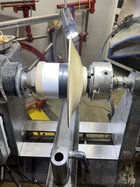I use a donut chuck successfully for finishing the bottom of my bowls, typically around 9" diameter. I usually part the bowl off before reversing and finishing the bottom with the donut chuck. The latest bowl I have turned I forgot to allow for the 1/8" space for the parting tool. If I part it off I will be compromising the form of this footless bowl. I have never used the donut chuck to actually part off the tenon. So the question is, does anyone have experience removing the tenon (2.5" diameter) in a donut chuck? I am worried that I might need to use too much lateral force for this chuck. The chuck is homemade and sturdy, constructed from 3/4" plywood and using 4 large bolts. Any help or comments are greatly appreciated!! Thanks.
-
November 2025 Turning Challenge: Wall Hanging! (click here for details) -
Congratulations to Craig Morton, People's Choice in the October 2025 Turning Challenge (click here for details) -
Congratulations to Andy Chen for "Mesquite Vase with Polymer Clay Millefiori" being selected as Turning of the Week for November 3, 2025 (click here for details) -
Welcome new registering member. Your username must be your real First and Last name (for example: John Doe). "Screen names" and "handles" are not allowed and your registration will be deleted if you don't use your real name. Also, do not use all caps nor all lower case.
You are using an out of date browser. It may not display this or other websites correctly.
You should upgrade or use an alternative browser.
You should upgrade or use an alternative browser.
Donut Chuck and Tenon removal
- Thread starter Will Armstrong
- Start date
- Joined
- Apr 27, 2004
- Messages
- 9,293
- Likes
- 6,041
- Location
- Lakeland, Florida
- Website
- www.hockenberywoodturning.com
Use the tailstock while you shape the bottom.
If it is easy take the pin out of the live center unless you use the center hole in the tenon to center the bowl in the doughnut chuck.
If you have a 5/8 diameter center you will have a 5/8 nub under the center.
You may be able to under cut this as a cone shaped nub
The nub can be cut off with a fine toothed saw.
Turning away the nub won’t put much pressure on the piece if you take light cuts.
If it is easy take the pin out of the live center unless you use the center hole in the tenon to center the bowl in the doughnut chuck.
If you have a 5/8 diameter center you will have a 5/8 nub under the center.
You may be able to under cut this as a cone shaped nub
The nub can be cut off with a fine toothed saw.
Turning away the nub won’t put much pressure on the piece if you take light cuts.
Last edited:
- Joined
- Apr 27, 2004
- Messages
- 9,293
- Likes
- 6,041
- Location
- Lakeland, Florida
- Website
- www.hockenberywoodturning.com
I turn a off the tenon to make a footless bottom when I demo an NE bowl from a crotch.
I use a friction drive jamb chuck but the turning with a doughnut chuck and tailstock support is the same.
A few screen shots from the video of the demo
Tenon revers chucked on a friction drive. Just the nub left
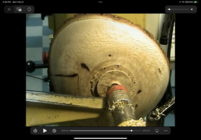 .
. 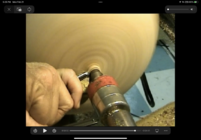 .
.
If you have it in doughnut chuck you can pull the tailstock away and turn the nub off.
Turning the nub to a cone. Once the point of the nub is close an 1/8” diameter I cut through turning the bowl by hand
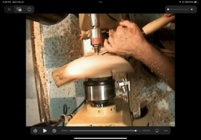 .
. 
If you want to see the process fast forward in the video to 53:45 and watch for 7 minutes.
View: https://youtu.be/8jVoI12Kfug
I use a friction drive jamb chuck but the turning with a doughnut chuck and tailstock support is the same.
A few screen shots from the video of the demo
Tenon revers chucked on a friction drive. Just the nub left
 .
.  .
. If you have it in doughnut chuck you can pull the tailstock away and turn the nub off.
Turning the nub to a cone. Once the point of the nub is close an 1/8” diameter I cut through turning the bowl by hand
 .
. 
If you want to see the process fast forward in the video to 53:45 and watch for 7 minutes.
Thanks so much Al for your thoughtful reply. I really wish I had thought of using the tailstock in combination with the donut chuck! Also, I liked your video! thanks again.
Will,
I would recommend against using a parting tool for ending your bowl turning. As you obviously know, it puts lateral force into the mix, and with face grain oriented wood, this is not a good match. Yes, you can do it, and lots of people do, but there's an easy way to take off the tenon without lateral stress. You need the 'nibbling cut'. (I made that up, famous people probably have a better name for it)
With the bowl reversed, you use a bowl gouge, or even a spindle gouge, with the flute roughly horizontal/closed. Press the lower tip of the gouge into the flat surface of the tenon, pressing toward the mounted rim of the bowl/headstock. You don't take a giant cut. Just press in until you are near the bottom of the bowl, nibbling a little off the edge of the tenon. Then advance and do it again, a short way closer to the center of the tenon. This puts any pressure toward the headstock/chuck, and there is no lateral pressure. This nibbling cut does not cut into the end grain, so it won't grab and it cuts easily.
Keep nibbling and you will end up with a rough or ridged surface once most of the tenon is gone, with a nib in the center due to the tailstock. You can make a pass or two with your gouge in a normal push cut fashion, taking a light cut, toward the center of the tenon to get a smooth, flat surface. If you want a curved bottom, and who doesn't, you can do the same with a light pull cut, shaping the curve as you go. (As with everything in woodturning, this is simple to understand when you see it but hard to describe--you can see it at 23+ minutes in Al's video)
Give it a try, I think you'll like it.
I would recommend against using a parting tool for ending your bowl turning. As you obviously know, it puts lateral force into the mix, and with face grain oriented wood, this is not a good match. Yes, you can do it, and lots of people do, but there's an easy way to take off the tenon without lateral stress. You need the 'nibbling cut'. (I made that up, famous people probably have a better name for it)
With the bowl reversed, you use a bowl gouge, or even a spindle gouge, with the flute roughly horizontal/closed. Press the lower tip of the gouge into the flat surface of the tenon, pressing toward the mounted rim of the bowl/headstock. You don't take a giant cut. Just press in until you are near the bottom of the bowl, nibbling a little off the edge of the tenon. Then advance and do it again, a short way closer to the center of the tenon. This puts any pressure toward the headstock/chuck, and there is no lateral pressure. This nibbling cut does not cut into the end grain, so it won't grab and it cuts easily.
Keep nibbling and you will end up with a rough or ridged surface once most of the tenon is gone, with a nib in the center due to the tailstock. You can make a pass or two with your gouge in a normal push cut fashion, taking a light cut, toward the center of the tenon to get a smooth, flat surface. If you want a curved bottom, and who doesn't, you can do the same with a light pull cut, shaping the curve as you go. (As with everything in woodturning, this is simple to understand when you see it but hard to describe--you can see it at 23+ minutes in Al's video)
Give it a try, I think you'll like it.
Once again...Al and Dean to the rescue! Good advice and methods described. Even if one is "lucky" with the parting tool ( that is how I feel when a turned object survives the experience.... - the opportunity for torn out grain from the parting tool is possible, and seems to happen too often.
- the opportunity for torn out grain from the parting tool is possible, and seems to happen too often.
Yes, these things are hard to describe- but you did a great job! I could understand your description exactly, but will certainly reference that section you mentioned of Al's great video. Nibble is the perfect word. Thanks for your time!Will,
I would recommend against using a parting tool for ending your bowl turning. As you obviously know, it puts lateral force into the mix, and with face grain oriented wood, this is not a good match. Yes, you can do it, and lots of people do, but there's an easy way to take off the tenon without lateral stress. You need the 'nibbling cut'. (I made that up, famous people probably have a better name for it)
With the bowl reversed, you use a bowl gouge, or even a spindle gouge, with the flute roughly horizontal/closed. Press the lower tip of the gouge into the flat surface of the tenon, pressing toward the mounted rim of the bowl/headstock. You don't take a giant cut. Just press in until you are near the bottom of the bowl, nibbling a little off the edge of the tenon. Then advance and do it again, a short way closer to the center of the tenon. This puts any pressure toward the headstock/chuck, and there is no lateral pressure. This nibbling cut does not cut into the end grain, so it won't grab and it cuts easily.
Keep nibbling and you will end up with a rough or ridged surface once most of the tenon is gone, with a nib in the center due to the tailstock. You can make a pass or two with your gouge in a normal push cut fashion, taking a light cut, toward the center of the tenon to get a smooth, flat surface. If you want a curved bottom, and who doesn't, you can do the same with a light pull cut, shaping the curve as you go. (As with everything in woodturning, this is simple to understand when you see it but hard to describe--you can see it at 23+ minutes in Al's video)
Give it a try, I think you'll like it.
Thanks for your reinforcement Tim. I do really dislike the anxiety that accompanies the uncertainty I feel when parting off! I might just "part ways" with that techniqueOnce again...Al and Dean to the rescue! Good advice and methods described. Even if one is "lucky" with the parting tool ( that is how I feel when a turned object survives the experience....- the opportunity for torn out grain from the parting tool is possible, and seems to happen too often.
The donut chuck may work on a thick walled bowl but the jam chuck provides better support because the inside bottom of the bowl is supported directly opposite of the live center and it is a lot quicker to setup. I have used that method to finish bottoms down to an 1/8" thick or less.
- Joined
- Apr 27, 2004
- Messages
- 9,293
- Likes
- 6,041
- Location
- Lakeland, Florida
- Website
- www.hockenberywoodturning.com
Yes, these things are hard to describe- but you did a great job! I could understand your description exactly, but will certainly reference that section you mentioned of Al's great video. Nibble is the perfect word.
Turning is a never ending learning process. Every time you learn something it leads to 3 more things you don’t know yet.
The best turning cuts are cross cuts with longer supporting fibers holding the fibers being cut in place.
@Dean Center ”nibble” is a good description. The cuts I use are a series of bevel riding push cuts. On the short tenon they don’t go very far to go so they are all entry cuts. The entry cuts are best begun with a “nibble” to make a smooth surface for the bevel to float over.
I too dislike using a parting tool in a ripping cut. It tears the fibers and can on occasion split the wood.
Sometimes it is the only way. However if you can cut away the tenon with gouges that leaves a nicer surface.
In a david Ellsworth class last century, our first class exercise was to Mount a 10x10 log section between centers. Turn a sphere. We then rotated the sphere 90 degrees and held it between centers and cut it in half using the straight hollowing tool - ripping cut. Then turned a bowl from one half and a hollowform from the other half.
Yes, good point, it would be quicker to set up. I will keep it in mind. thanksThe donut chuck may work on a thick walled bowl but the jam chuck provides better support because the inside bottom of the bowl is supported directly opposite of the live center and it is a lot quicker to setup. I have used that method to finish bottoms down to an 1/8" thick or less.
Thanks for the additional pointers Al. I am grateful for all the wisdom I am finding in this forum! As for the Ellsworth exercise... I will maybe give that a try some day in the distant futureTurning is a never ending learning process. Every time you learn something it leads to 3 more things you don’t know yet.
The best turning cuts are cross cuts with longer supporting fibers holding the fibers being cut in place.
@Dean Center ”nibble” is a good description. The cuts I use are a series of bevel riding push cuts. On the short tenon they don’t go very far to go so they are all entry cuts. The entry cuts are best begun with a “nibble” to make a smooth surface for the bevel to float over.
I too dislike using a parting tool in a ripping cut. It tears the fibers and can on occasion split the wood.
Sometimes it is the only way. However if you can cut away the tenon with gouges that leaves a nicer surface.
In a david Ellsworth class last century, our first class exercise was to Mount a 10x10 log section between centers. Turn a sphere. We then rotated the sphere 90 degrees and held it between centers and cut it in half using the straight hollowing tool - ripping cut. Then turned a bowl from one half and a hollowform from the other half.
@Will Armstrong It seems that there are a number of ways to remove the tenon, depending on what accessories you own. However, given that you own a doughnut chuck, that certainly can be used. I own a doughnut chuck and have used it when removing the tenon for certain types of bowls. While putting a lot of force against the tenon might make the bowl move, it's unlikely I think since the function of the doughnut chuck is to hold the bowl in place. securely preventing it from coming off the lathe. I don't use mine very much since, for most bowls, there are other ways to turn the tenon off as others have already said. Given the time that it usually takes to mount the bowl in the doughnut chuck so that it doesn't wobble, you could possibly have part of another bowl done. It is a very secure mounting method for tenon removal and and it does allow complete removal of the tenon while on the lathe.
Thank you Randy for your response. I was successful with the donut chuck, using the techniques outlined by others. I did also want to embellish the bottom, so the donut chuck was the choice for this one.
Tom Gall
TOTW Team
Or, a vacuum chuck!Thank you Randy for your response. I was successful with the donut chuck, using the techniques outlined by others. I did also want to embellish the bottom, so the donut chuck was the choice for this one.
A Frugal Vacuum chuck + a chuck reverser = rapid re-centering to remove the foot of a bowl/platter, etc.....My favorite option.Or, a vacuum chuck!


Tom Gall
TOTW Team
Once again wood turning terminology (semantics) rears its ugly head.The donut chuck may work on a thick walled bowl but the jam chuck provides better support because the inside bottom of the bowl is supported directly opposite of the live center and it is a lot quicker to setup. I have used that method to finish bottoms down to an 1/8" thick or less.
What you describe as a "jam" chuck I would call a "friction" chuck - it doesn't work unless pressure is applied by the tailstock live center to apply drive friction. A true "jam" chuck doesn't need the tailstock - but should be used for safety until the final light cuts. Both methods have their advantages depending on the situation.
Tom Gall
TOTW Team
Mine too. If you have a center mark (divot) on your tenon or recess no chuck (reverser?) is needed.A Frugal Vacuum chuck + a chuck reverser = rapid re-centering to remove the foot of a bowl/platter, etc.....My favorite option.
Agreed Tom. There are times I have slapped myself for not making/leaving a mark. Tho - mostly I start a piece between centers, so there is a mark where the point from the spur drive marked it.
For removing the evidence of how the piece was held, or to return the recess, or turn a recess on on a piece that has none ( like old rough turned ones that were held with screws on the bottom) I use the Oneway Jumbo and Mega Jumbo jaws, hold is good enough for me to even return the outside while it's held I the Jumbo jaws.
Got a picture here were I am returning a dried Applewood bowl while held like that, and returned the recess as well, you can see how much the wood did get oval, I also used wedges (with tape over them to hold in place) so the bowl would not rock while turning.
There is another (1 of three) bowl sitting on the ways that shows the screw holes that I used in 1998 when I rough turned those bowls, it has been also returned in the same way, this way even turnings with holes in them can be held securely.
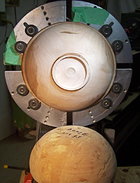
Got a picture here were I am returning a dried Applewood bowl while held like that, and returned the recess as well, you can see how much the wood did get oval, I also used wedges (with tape over them to hold in place) so the bowl would not rock while turning.
There is another (1 of three) bowl sitting on the ways that shows the screw holes that I used in 1998 when I rough turned those bowls, it has been also returned in the same way, this way even turnings with holes in them can be held securely.

Or, a vacuum chuck!


thanks Leo!For removing the evidence of how the piece was held, or to return the recess, or turn a recess on on a piece that has none ( like old rough turned ones that were held with screws on the bottom) I use the Oneway Jumbo and Mega Jumbo jaws, hold is good enough for me to even return the outside while it's held I the Jumbo jaws.
Got a picture here were I am returning a dried Applewood bowl while held like that, and returned the recess as well, you can see how much the wood did get oval, I also used wedges (with tape over them to hold in place) so the bowl would not rock while turning.
There is another (1 of three) bowl sitting on the ways that shows the screw holes that I used in 1998 when I rough turned those bowls, it has been also returned in the same way, this way even turnings with holes in them can be held securely.
View attachment 43428
Thanks for the reference to the Frugal vacuum chuck. I will have a look at that once I save up enough of my allowance ;-)A Frugal Vacuum chuck + a chuck reverser = rapid re-centering to remove the foot of a bowl/platter, etc.....My favorite option.
Hi Tim- Can I ask about your reference to a "chuck reverser" please? I'm not familiar. Much thanks!Thanks for the reference to the Frugal vacuum chuck. I will have a look at that once I save up enough of my allowance ;-)
And here are 2 kinds you can use. The first link is for one that is a "live center type" - meaning, it has bearing so it turns. My be useful for some interesting things, but really for re-centering, a solid one - without bearings - will work fine.
With bearings-https://www.amazon.com/PSI-Woodworking-Products-LTCA18-Tailstock/dp/B004CVJC1Q/ref=asc_df_B004CVJC1Q/?tag=hyprod-20&linkCode=df0&hvadid=312003160272&hvpos=&hvnetw=g&hvrand=13079269641992006751&hvpone=&hvptwo=&hvqmt=&hvdev=c&hvdvcmdl=&hvlocint=&hvlocphy=1020991&hvtargid=pla-434189476926&psc=1
Without bearings - https://www.grizzly.com/products/st...MIlv7l8aOm9gIV-RPUAR2GtgUTEAsYAiABEgJ-FfD_BwE
In both case - you need to match the morse taper size to what your lathe has ( usually M2 ) and the threaded end with the spindle size on your lathe so that your chucks will thread on to it.
With bearings-https://www.amazon.com/PSI-Woodworking-Products-LTCA18-Tailstock/dp/B004CVJC1Q/ref=asc_df_B004CVJC1Q/?tag=hyprod-20&linkCode=df0&hvadid=312003160272&hvpos=&hvnetw=g&hvrand=13079269641992006751&hvpone=&hvptwo=&hvqmt=&hvdev=c&hvdvcmdl=&hvlocint=&hvlocphy=1020991&hvtargid=pla-434189476926&psc=1
Without bearings - https://www.grizzly.com/products/st...MIlv7l8aOm9gIV-RPUAR2GtgUTEAsYAiABEgJ-FfD_BwE
In both case - you need to match the morse taper size to what your lathe has ( usually M2 ) and the threaded end with the spindle size on your lathe so that your chucks will thread on to it.
Thanks Tim! I have found one at a local supplier that I am going to order. Looks like a good investment.And here are 2 kinds you can use. The first link is for one that is a "live center type" - meaning, it has bearing so it turns. My be useful for some interesting things, but really for re-centering, a solid one - without bearings - will work fine.
With bearings-https://www.amazon.com/PSI-Woodworking-Products-LTCA18-Tailstock/dp/B004CVJC1Q/ref=asc_df_B004CVJC1Q/?tag=hyprod-20&linkCode=df0&hvadid=312003160272&hvpos=&hvnetw=g&hvrand=13079269641992006751&hvpone=&hvptwo=&hvqmt=&hvdev=c&hvdvcmdl=&hvlocint=&hvlocphy=1020991&hvtargid=pla-434189476926&psc=1
Without bearings - https://www.grizzly.com/products/st...MIlv7l8aOm9gIV-RPUAR2GtgUTEAsYAiABEgJ-FfD_BwE
In both case - you need to match the morse taper size to what your lathe has ( usually M2 ) and the threaded end with the spindle size on your lathe so that your chucks will thread on to it.
My pleasure Will!
It is a reasonable priced item that extends your equipment's abilities. I use it just for positioning a piece not eh vacuum chuck to make turning the foot of a bowl easier. So - the "fixed" or non- rotating one works fine for that. But I also have the one with bearings...and am thinking about other ways to use it.
Best!
T
It is a reasonable priced item that extends your equipment's abilities. I use it just for positioning a piece not eh vacuum chuck to make turning the foot of a bowl easier. So - the "fixed" or non- rotating one works fine for that. But I also have the one with bearings...and am thinking about other ways to use it.
Best!
T

